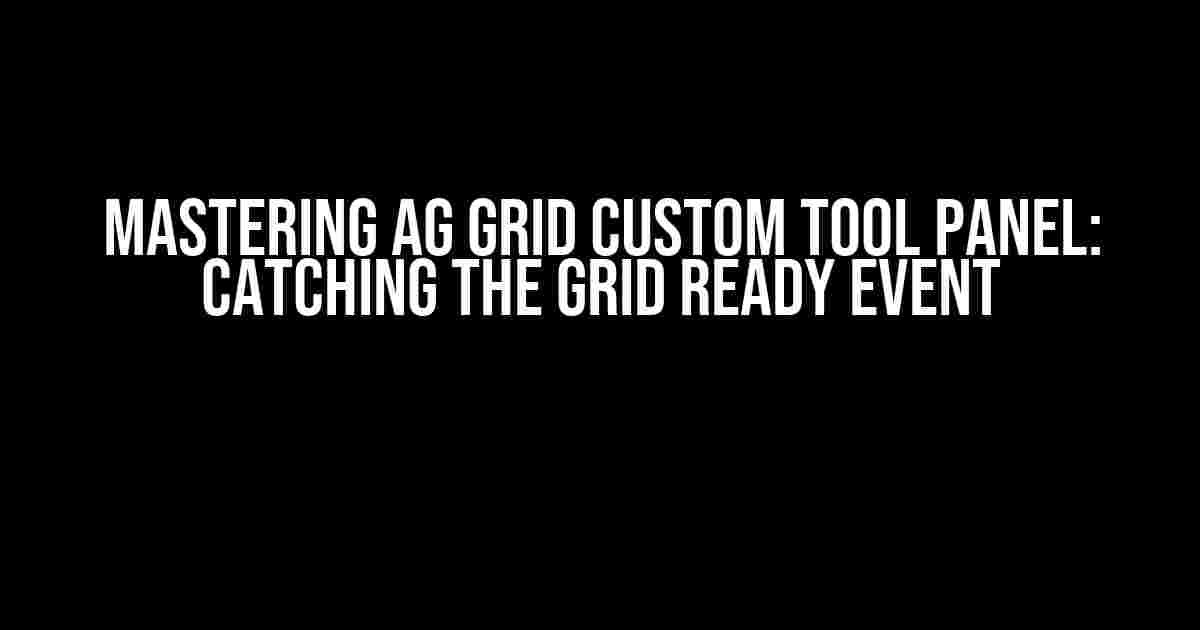Are you tired of using the default tool panel in AG Grid? Do you want to take your data grid to the next level by creating a custom tool panel that meets your specific needs? Look no further! In this article, we’ll dive into the world of AG Grid custom tool panels and explore how to catch the grid ready event to get the most out of your grid.
What is AG Grid?
AG Grid is a popular JavaScript data grid library that provides a powerful and feature-rich grid component for building enterprise-level applications. With AG Grid, you can create complex data grids with ease, complete with features like filtering, sorting, grouping, and more.
What is a Custom Tool Panel?
A custom tool panel is a user-defined panel that can be added to the AG Grid to provide additional functionality or features. By creating a custom tool panel, you can tailor the grid to your specific needs and provide a more personalized experience for your users.
Why Catch the Grid Ready Event?
The grid ready event is an essential event in AG Grid that signifies when the grid has finished rendering and is ready for interaction. Catching this event is crucial when creating a custom tool panel, as it allows you to perform actions or initialize components once the grid is fully loaded.
By catching the grid ready event, you can:
- Initialize custom components or widgets
- Perform data manipulation or calculations
- Enable or disable grid features
- And more!
Creating a Custom Tool Panel
To create a custom tool panel, you’ll need to define a new component that will serve as the tool panel. For this example, we’ll create a simple React component that will display a button.
import React from 'react';
const CustomToolPanel = () => {
return (
);
};
export default CustomToolPanel;
Next, you’ll need to add the custom tool panel to the AG Grid by passing it as a property to the grid component.
import { AgGridReact } from 'ag-grid-react';
import CustomToolPanel from './CustomToolPanel';
const App = () => {
return (
Catching the Grid Ready Event
To catch the grid ready event, you can use the `onFirstDataRendered` prop provided by AG Grid. This prop is a callback function that will be executed once the grid has finished rendering and is ready for interaction.
import { AgGridReact } from 'ag-grid-react';
import CustomToolPanel from './CustomToolPanel';
const App = () => {
const onFirstDataRendered = () => {
console.log('Grid is ready!');
};
return (
In the above example, the `onFirstDataRendered` callback function is executed once the grid has finished rendering, and it logs a message to the console indicating that the grid is ready.
Performing Actions on Grid Ready
Now that we’ve caught the grid ready event, we can perform actions or initialize components within the callback function. For example, let’s say we want to initialize a custom component within the tool panel once the grid is ready.
import { AgGridReact } from 'ag-grid-react';
import CustomToolPanel from './CustomToolPanel';
const App = () => {
const onFirstDataRendered = () => {
const toolPanel = document.querySelector('.ag-tool_panel');
const customComponent = new CustomComponent(toolPanel);
customComponent.init();
};
return (
In the above example, we’re using the `onFirstDataRendered` callback function to initialize a custom component within the tool panel once the grid is ready.
Best Practices for Catching the Grid Ready Event
When catching the grid ready event, it’s essential to follow best practices to ensure that your code is efficient and reliable. Here are a few tips to keep in mind:
- Use the `onFirstDataRendered` prop: This prop is specifically designed for catching the grid ready event, and it’s the recommended way to perform actions once the grid has finished rendering.
- Avoid using setTimeout: Using `setTimeout` to delay the execution of code can lead to unexpected behavior and is generally considered a bad practice.
- Keep your code concise: Try to keep your code concise and focused on the task at hand. Avoid performing complex operations within the `onFirstDataRendered` callback function.
Conclusion
In this article, we’ve explored the world of AG Grid custom tool panels and learned how to catch the grid ready event using the `onFirstDataRendered` prop. By following the instructions and best practices outlined in this article, you can create custom tool panels that meet your specific needs and provide a more personalized experience for your users.
Remember to keep your code concise, avoid using `setTimeout`, and use the `onFirstDataRendered` prop to catch the grid ready event. With these tips and techniques, you’ll be well on your way to creating stunning AG Grid applications that delight and impress your users.
| Best Practice | Description |
|---|---|
| Use the `onFirstDataRendered` prop | Use the `onFirstDataRendered` prop to catch the grid ready event and perform actions once the grid has finished rendering. |
| Avoid using setTimeout | Avoid using `setTimeout` to delay the execution of code, as it can lead to unexpected behavior and is generally considered a bad practice. |
| Keep your code concise | Keep your code concise and focused on the task at hand, and avoid performing complex operations within the `onFirstDataRendered` callback function. |
By following these best practices, you can ensure that your AG Grid application is efficient, reliable, and provides a great user experience.
Frequently Asked Question
Get ready to unlock the secrets of AG Grid Custom Tool Panel and catch that elusive Grid Ready Event!
What is the Grid Ready Event in AG Grid?
The Grid Ready Event is a crucial event in AG Grid that signals the grid has finished rendering and is ready for interaction. It’s the perfect moment to initialize your custom tool panel or perform any necessary actions that require the grid to be fully loaded!
How do I catch the Grid Ready Event in my custom tool panel?
Easy peasy! You can catch the Grid Ready Event by adding an event listener to your grid’s `onFirstDataRendered` or `onGridReady` events. These events will notify you when the grid is ready, and you can then initialize your custom tool panel or perform any necessary actions.
What is the difference between onFirstDataRendered and onGridReady events?
While both events are related to the grid being ready, `onFirstDataRendered` is fired when the grid has finished rendering the initial dataset, whereas `onGridReady` is fired when the grid is fully initialized and ready for interaction. So, if you need to perform actions that require the grid’s data, use `onFirstDataRendered`. If you need to perform actions that require the grid to be fully initialized, use `onGridReady`.
Can I use the Grid Ready Event to update my custom tool panel?
Absolutely! The Grid Ready Event is the perfect opportunity to update your custom tool panel with the latest grid data or perform any necessary actions. You can use this event to refresh your panel’s content, update its state, or even hide/show certain elements based on the grid’s configuration.
Are there any best practices for handling the Grid Ready Event?
Yes, indeed! When handling the Grid Ready Event, make sure to keep your event listener functions lightweight and performant. Avoid performing heavy computations or complex actions that might slow down the grid’s rendering. Also, consider debouncing or throttling your event listener to prevent excessive calls to your handler function.



